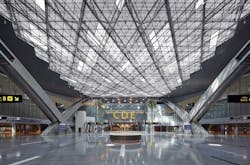The future of airport terminal design: destination status, five-star amenities, stress-free travel
In today’s hospitality-inspired airport terminal environment, travelers historically referred to as “passengers” and then “customers” are now being treated like “guests.”
Airlines and airport operators are easing travel anxiety and luring travelers by providing comfortable, exceptional experiences. Though these “passenger as guest” and “destination airport” concepts aren’t new, they are no longer optional for airports wanting to compete in the global market.
Achieving destination status
Next-generation airports offer much more than shops, restaurants and free Wi-Fi. The air side of the new passenger terminal complex at Hamad International Airport (HIA) in Doha, for instance, includes two five-star hotels and a health spa with a lap pool.
Other amenities at the HIA, which is positioning itself to be one of the world’s leading transfer hubs, include a 28,000-sm retail and concessions gallery, a 2,100-sm public mosque, a museum-quality art program, two large first-class lounges and two business-class lounges, as well as activity nodes where all travelers can rest, access children’s play areas and enjoy a meal.
With more than 340 retail and catering outlets across 52,000 square meters of retail space, London Heathrow Airport’s reported £891.7 million of retail sales in 2012, making it the leading retailer among the world’s airports. The diversity of airport offerings is growing. This year, both Chanel and Rolex are opening two-story, standalone luxury shops in Hong Kong International Airport.
Airports that forgo destination status risk losing out on significant revenue opportunities. A 2010 J.D. Power and Associates Airport Satisfaction Study reported that delighted passengers spend 45 percent more money per airport visit than those who were disappointed.
The service factor
Airports have historically controlled the terminal processes, leaving customer service to the airlines. Today’s competitive environment demands collaboration between each entity and careful management of the guests’ entire experience, from the moment they book their flight until they arrive at their destination.
Airports can improve the customer experience in their facilities, concessions, passenger processing and customer services. A 2013 Airport Cooperative Research Program (ACRP) study highlighted the most competitive factors for airports pursuing the highest level of service quality:
• Speed of guest movement through the airport
• Cleanliness and ambiance of the terminal, concourses and gate areas
• Excellent selection of concessions/services and value for money
• Positive gate experience
• Exceptional customer service and courtesy of staff
To streamline the journeys of anxious travelers, our design teams are using computer simulations that model passenger flows and guide the planning and design of optimum check-in, security, circulation and other processing points.
Before an airport can be considered a destination with loyal customers, service must transcend the harried, impersonal interactions typical of the traditional airport. Singapore’s Changi Airport, for example, has won top prize in the World Airport Awards four times despite lacking the sheen of newer competitors. Highly personalized customer service sets it apart.
Technology helps
Airport terminal planners and designers must continue to stay ahead of and provide flexibility to incorporate emerging technologies.
As with hotels, technology helps improve the airport experience for guests who can access real-time information and customize their experiences with service improvements ranging from faster transfer times to the ability to easily find comfortable airport hotels.
The Heathrow mobile app eases and enhances the guest experience with special offers and travel planning tools including live flight updates, city guides, premium parking spot booking, and Heathrow shop and restaurant listings. The app contributes to a seamless, personalized experience fully controlled by the guest.
A community gateway
To become destinations, airports must align themselves with the community. They need to convey a specific sense of place rather than a generic vibe.
The Indianapolis International Airport’s Col. H. Weir Cook Terminal is an example of establishing a distinctive, place-based character that provides guests a memorable experience. In this airport, a grand “civic plaza” features a 200-foot-wide skylight and window wall that floods the space with natural light. Views of the downtown Indianapolis skyline combine with civic displays and retail offerings to connect guests to the local culture and land. A unique Cultural Crossroads museum shop in Civic Plaza features merchandise from eight area museums and cultural institutions.
End-to-end experience influenced by all stakeholders
Airport leaders and design firms continue to explore new ways to enhance the overall travel experience. All entities – including the airport, airlines, retail tenants, regulatory agencies and local businesses – must partner to share the data required to create the ideal guest experience. This new model of collaboration, which requires an unprecedented level of integrated operations, ensures that the end-to-end guest experience positions the airport as a destination in its own right.
This report originally appeared in Passenger Terminal World’s 2014 Showcase.
About the Author
Richard Gammon is Director of Aviation + Transportation at HOK.
Read more posts from Life at HOK.
About the Author

Life at HOK
HOK is a global design, architecture, engineering and planning firm. Through a network of 24 offices, HOK provides design excellence and innovation to create places that enrich people's lives and help clients succeed. Life at HOK is a group blog authored by the firm’s creative people across the world. Visit hoklife.com.
